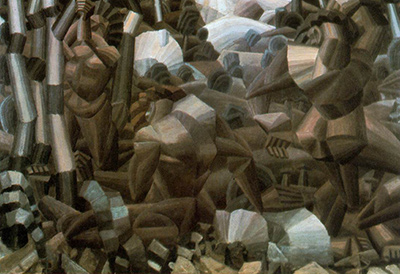As Cubism gained popularity in the early 20th Century, many artists began to experiment with the avant-garde movement. By playing with an already controversial style and developing it into his own distinct image, Fernand Leger remains an important name in the cubist movement.
Paintings such as Nudes in the Forest (1910) show his earlier shift from Impressionism into this more unusual style. Cubism is inspired by breaking an image into its parts rather than showing them as realistic. In Nudes in the Forest, Leger takes a monochrome approach which combines the shapes of humans with the shapes of trees, creating a beautiful and confusing canvas that draws the eye and confounds the mind. Instead of the flat style of many cubist artists of the time, Leger is distinct in the fact that he continues to create three dimensional shapes in his art. It is possible to see that in this painting, where the cylinders of the trees and limbs seem to ripple and pile across the image, giving it depth beyond many of his peers. Though the colours could seem unimpressive compared to the work of other cubists, Leger uses shape and form more than colour in Nudes in the Forest to create interest.
The use of cylinders in such a way is linked to the fascination in Leger's time with the industrialisation that was happening at the time, and the interest in robots that translates into his art. In fact, it could be said that the piles of shapes in Nudes in the Forest almost appears as a heap of robotic parts, all combined into one unusual piece of art that is open to many interpretations. It is always interesting to view an important artist's early work, and in this case it shows Leger's tendency to use the prevalent art trends to create his own path. Nudes in the Forest was his first major piece of cubism, a path that would eventually take him on to be one of the main influences in the Pop Art movement. That said, Leger remains today known, first and foremost, as a Cubist painter whose own unique take on that movement is sometimes known as Tubism.
Nudes in the Forest is dated specifically as being between 1909-1911 by its owners, the Kroller Muller Museum in the Netherlands. They also specify the dimensions of the piece as being 120cm tall x 170cm wide and give its original French title as being Nus dans la forêt. It remains one of the most significant paintings within their collection because of the influential nature of Leger's work. The palette used here is fairly subdued and this was purposely so as Leger wanted the volumes of form to take centre stage rather than distract viewers with some of his bright colours. You will find similar within the work of Gris and Braque who often produced whole scenes in variants of dark brown, similar to how a newspaper would look at that time.
The Kroller Moller Museum actually own a total of 14 works by Leger in total, making it an excellent destination for those interested in this famous artist. Much of his work has been dispersed fairly widely across Europe and North America meaning that it is rare to find this much under one roof. Some of the titles of these other paintings and drawings include Composition, The Typographer, Mechanical Element and also Soldiers Playing Cards. They also have a good selection from the career of native artist, Vincent Van Gogh as well as a sculpture garden which features Jean Dubuffet and a number of Dutch sculptors. This remains one of the best locations in the Netherlands from which to enjoy some high profile art and they continue to improve and expand the collection on an annual basis.




